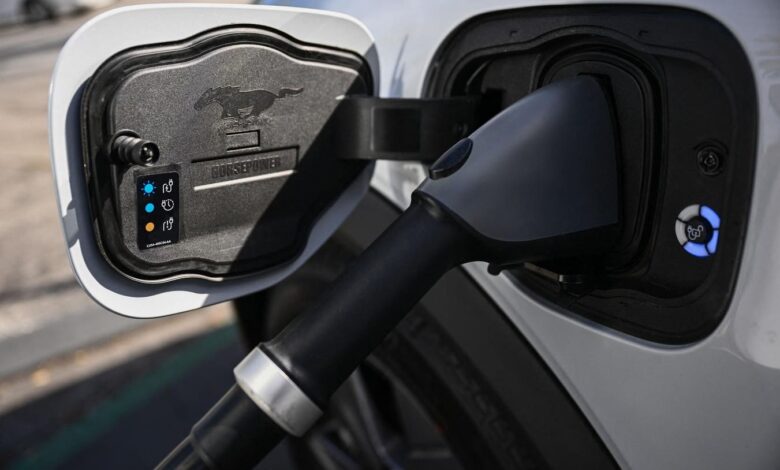After The EV Fire Sale ‒ What Comes Next

📝 usncan Note: After The EV Fire Sale ‒ What Comes Next
Disclaimer: This content has been prepared based on currently trending topics to increase your awareness.
An electric vehicle (EV) charges via a CCS DC fast charger from Electrify America at a shopping mall parking lot in Torrance, California, on February 23, 2024. (Photo by Patrick T. Fallon / AFP) (Photo by PATRICK T. FALLON/AFP via Getty Images)
AFP via Getty Images
The phasing out of federal tax credits for EVs is creating a predictable rush for consumers, dealers and automakers alike, but as this occurs real time one must ponder, what next?
Nobody should have been surprised when President Trump and the Republican-controlled Congress eventually ended the federal $7500 tax credit. And now that we are within a month of its completion, nobody should be surprised with the fire-sale-like atmosphere to take advantage of it before it ends, as August 2025 is expected to reveal a record month for EV sales once the tally is complete.
However, this fire sale is more of a fire lease, as the incentives are heavier for leases. Per the research firm Edmunds, the average lease price for EVs in August 2025 was $624 per month versus $670 per month for an internal combustion vehicle. This is no accident, as stipulations in the language of the incentive allow the dealer, not the purchaser, to be considered the owner allowing the lessee ability to gain the benefit of the credit regardless of income. For the most part, EV purchases do not generate the same discount rates as leases since the dealership would no longer be able to claim the full credit regardless of vehicle price, assembly location, battery sourcing, or lessee income. Therefore leases offer more dealership flexibility. The result is not surprising, in July EV leases accounted for about 75% of EV transactions compared to 16% of gas-powered vehicle transactions.
This is a compelling approach, as the lessor traditionally owns residual risk in an automotive lease transaction. Automotive OEMs will use captive finance arms (even if legally separate) as a strategic tool to drive sales. Since leases are a specific transaction where the dealer buys the vehicle, marketing incentives from the OEM may be necessary to address the marketability of slower moving vehicles.
So coupling the soon-to-be expired EV tax credits with a forecasted drop in EV sales upon credit expiration creates a predictable situation. Vehicles once thought out of reach are priced to move. In some hot spots, like Colorado, one can find $40 per month leases on a Kiro Niro EV, a $189 per month lease on a EV9 that has a $65,000 sticker price and a $169 per month lease on a Nissan Ariya with a $57,000 sticker.
But once September 30 is behind us, what happens next?
A recent dip at the end of 2024 cut short a consistent rise in EV share of overall new U.S. vehicle sales which had been intact since COVID. The sales outlook for EVs in the U.S. is looking bleak as domestic policy headwinds have taken the tax credit away along with the relaxation of regulatory pressures on internal combustion powered vehicles. These headlines dominate the EV news landscape domestically but there are positive signs to consider.
Many states are poised to fund their own EV tax credits. A total of at least 20 offer some form of tax break for EV purchases and leases. Additionally EV buyers tend to be sticky, staying loyal to EVs after making the initial shift.
But these are more anecdotal signals which do not reveal a high confidence that EV sales will maintain any resemblance of what they are projected to be in the last months of the U.S. tax credit. It is true that the domestic automakers have pulled planned investments for EV production and battery production, but perhaps there are some “green shoots” to show there will be significant domestic EV production beyond the tax credit.
When the focus switches from the United States to the world, the share of vehicles doubles from 10% of new sales to 20%. This growth is jettisoned by EV sales and China is at the forefront. In 2023, China surpassed Japan as the world’s largest automotive exporter. In 2024, Chinese automakers produced over 31 million units, with EVs accounting for 41% of that figure. (For comparison, the U.S. domestic auto market was roughly 16 million). BYD, the Chinese EV juggernaut, edged out Tesla in 2024 to produce the largest number of EVs globally. So while the momentum for EV sales and leases may be slowing in the U.S., the momentum around the globe seems to march on.
Perhaps this is what Jim Farley, the CEO of Ford, had in mind when he stated he has a Chinese-made EV and loves it. Specifically, he was speaking of the Xiaomi SU7. While this company is not BYD, it does benefit from being well-positioned with the economic forces that allow Chinese companies to excel in the global EV market ‒ low labor costs, simpler battery supply chains thanks to domestic access to rare earth minerals and government-subsidized research and development. Experts believe China is poised to dominate the global EV market and believe we are only seeing “the beginning.”
So Ford’s decision to invest almost $2 billion in a Louisville-based factory to produce a mid-sized EV truck with a $30,000 sticker price should not be surprising when considering this global perspective. The risk of falling further behind Chinese EV producers for the still-growing EV market across the world should be enough for the U.S. automakers to remain active in EV investments. While the rate of investment in U.S. EV production capacity has admittedly slipped, a too-sudden exit may not be amenable to compete across the globe.




